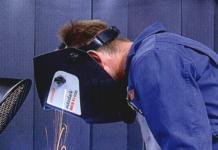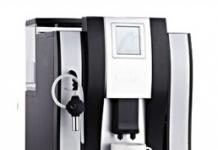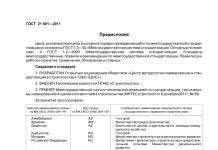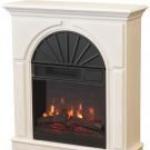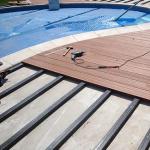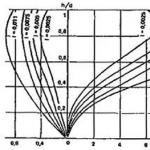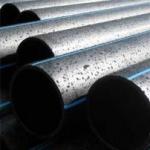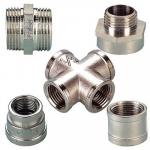In technical terms, welding inverters are the same welding machines, only more modern, working on semiconductors. It uses exactly the same technologies as in semi-automatic machines, argon-arc and plasma cutting is performed in the same way, as well as.
Undoubted advantages
Actually, an inverter is a power converter. Accordingly, the difference between a welding inverter and a conventional transformer is as follows:
- its useful efficiency is from 80 to 90 percent, so when converting direct current to alternating current, and then alternating current to direct current again, not very little power is lost;
- in order to control the conversion processes, a processor is used, and, depending on the strength of the voltage, and sometimes its dips, the conversion coefficient changes, which allows you to keep the output voltage at a constant level.
welding theory
All that is required of the welder is to smoothly move the electrode along the line of the intended seam, without touching the metal, so that the electrode is a few millimeters from it. In fact, a simple theory turns into flour, since working in a mask into which sparks fly does not make it easy execution.
Using a conventional transformer when touched turns into a short circuit. In order to tear it off, certain efforts are required, otherwise the thermal protection works or the transformer winding lights up.
If an inverter is used, then the touch is almost imperceptible: the processor that instantly reacts to a voltage drop melts the electrode and can be taken away from the part without any effort.
Of the other cases where our clumsy actions are masked by a "smart" inverter, we note the practice when the electrode is deliberately kept in close proximity to the welding object. In this case, the processor stops the output voltage, and overheating can be avoided.
The undoubted advantage of the inverter is its low weight and size, which cannot even be compared with the previous transformer. And all because the power conversion here occurs at 50-60 kHz.
The welding tool of the new millennium gives the impression of a good wizard, with it the welding process becomes simple, fast and convenient. And not only for the professional. Even a beginner can feel like such a professional, with an inverter in his hands. 
Summing up the above, we can note among the advantages of the advantages of the tool in the form of:
- very tangible power density;
- significantly reduced weight;
- wide choice and simplicity of adjustments available on the body;
- convenient sizes, including for mobile transportation;
- the minimum number of consumable electrodes;
- high performance;
- the possibility of welding in a horizontal plane, vertically and at an angle;
- advantages of welding various metals, including "stainless steel", cast iron and non-ferrous metals;
- ease of compatibility with a wide range of electrodes;
- modular repurposing potential.
Obvious disadvantages
Why, with such an abundance of advantages of inverters, the old welding transformers have not yet been written off to the notorious dustbin of history? The main reason why some potential consumers continue to use older, more familiar transformers is the price. The inverters that replaced them are at least twice as expensive.
The second of the shortcomings visitors to various forums on the Internet are sure to mention the high process of decommissioning a tool. One has only to get dirty on the electronic board - and the unit refuses to work. Therefore, it constantly needs to be blown with compressed air.

The small size of the new welding unit also has its downside. After all, it is extremely saturated with all kinds of electronics, the normal operation of which can be easily interrupted by capricious weather. "Smart" stuffing is more sensitive, both to dampness and to sub-zero temperatures. As soon as the temperature drops below zero, a number of budget models begin to fail, and branded products - at temperatures below -15 degrees. And the storage of such equipment in severe frosts (in winter, in an ordinary Russian garage) reduces the reliability of a “delicate” tool.
Problems also arise when working in dusty conditions. If the product is not blown in time, its failure is just a matter of time.
Not everything is so simple with the welding itself. This applies to cutting thick metal. If the mains voltage is unstable, which is quite common in rural areas, then the conversion module may fail. Therefore, characterizing the inverter as a new word in the welded business, it is hardly worth idealizing it too much. Yes, it's the best there is. But this is far from a panacea.
The next big disadvantage of the product is very expensive repair. After all, the operation of the inverter is based on a transistor IGBT block, the price of which can range from a quarter of the cost to half of the face value of the entire product. Therefore, if the warranty period of the unit has expired, its “resuscitation” will require significant financial investments. Part of the model range is far from the best maintainability. The lack of service centers can have a negative impact, especially in rural areas, where inverters are in demand in private farmsteads and, of course, in small farms.

The situation is also complicated by the fact that it is unrealistic to assemble an IGBT block yourself, even with all the necessary microcircuits at hand. You need to buy a brand block. But there are budget models on sale, the design of which is limited to the presence of only one electronic board. In this case, the breakdown will cost not even 50, but 60 percent of the cost of the product.
Of course, all these problem areas more than pay off, one has only to remember the bulky transformers spitting melt, uncomfortable. Next to them, a mobile, comfortable, almost silent, energy-efficient inverter appears in a completely different light. And the quality of the result, even if a beginner takes up the matter, turns out to be quite acceptable.
Each of the novice welders who want to purchase similar equipment for their home thought about the difference between a welding machine and an inverter.
The first option is extremely easy to operate, but bulky, heavy, and the functionality is limited, plus a large consumption of electrical energy.
The second option is practical: it produces a connection of metals in any plane with good performance, but is afraid of low temperatures, and its high cost scares off potential buyers.
To resolve the issue: or which transformer is better, it is necessary to consider in detail the features of the operation of each unit. For many years, it was transformer equipment that was considered ideal for a strong connection of metal structures and parts, it was used for cutting metal if the power of the gas cutter was not enough.
The design of similar equipment is not complicated: two windings, one of which receives alternating current from the network. The units were produced with a connection to a three-phase network, they are divided into large and small, but both options are distinguished by a large mass. For the performer, such equipment is safe, because the idle voltage does not rise above 48 V.
The transformer apparatus is used for welding carbon steels, cast iron products and even aluminum. Small units use stepped switching, and in large devices, regulation occurs due to the convergence or separation of the windings over a certain distance.
Inverters are devices with electronic filling, with which alternating current is converted to direct current and vice versa. Similar
the equipment is much more compact in size and weight, so you can use it anywhere, conveniently arranging an elegant body on the shoulder strap. Such small dimensions are achieved through the use of nanotechnology. That, in principle, is all that distinguishes a transformer welding machine from an inverter.
Important! Not every home master will be able to allocate funds from the household budget for the purchase of an inverter, since similar equipment pays off only with frequent use.
Differences between them
For clarity and to resolve the issue of how an inverter differs from a transformer, we present a table of the main parameters of these units.
| Characteristic | transformer apparatus | inverter |
| Voltage Options | 220-380V ±5-10% | 220-380V +15%, -30% |
| Protection | shutdown in case of short circuit | transition to idle: in case of short circuit, overheating, sticking of the electrode |
| Current parameters/adjustment | variable/coarse | variable and constant / smooth |
| Additional functions | not available | Adjustment of current strength according to welding parameters; easy activation of the arc; · Strength of the arc; Disconnection of the product when the electrode sticks. |
| Machine weight | imposing | small |
| Required qualifications of the performer | no work experience | high |
| Mobility | low | high |
| efficiency | no more than 50% | high |
| Repair price | low | very high |
| KP (discontinuity factor) | absent | at maximum current |
| Current value | no restrictions | CP restrictions |
The conclusion is this: it is easier to use a transformer for novice welders to gain experience, and then switch to an inverter.
Yu. I. Alekseev, education: vocational school, specialty: welder of the 6th category, work experience: since 1998: « The choice of welding equipment largely depends on the organization's budget, but a diligent business executive will always find funds to purchase a high-performance machine in order to improve the quality of work.
Where is it applied?
 To make the right decision about which welding transformer or inverter is better, you need to consider their advantages and disadvantages, as well as find out in which cases one or another device should be used.
To make the right decision about which welding transformer or inverter is better, you need to consider their advantages and disadvantages, as well as find out in which cases one or another device should be used.
Transformer units
- simple design;
- reliable operation, inexpensive repair;
- low price;
- not afraid of overheating, as well as sub-zero temperatures when working in open areas;
- there are no parts in the design that will fail in case of mechanical damage.
- negatively relates to voltage drops;
- coarse adjustment of parameters;
- large size, heavy weight;
- a three-phase line is required;
- high power consumption.
Transformers have the same amount of positive and negative.
Inverter devices
Positive qualities of inverters:
- compact size and light weight;
- many functions that improve the quality of welding;
- accurate scale settings;
- low electricity consumption;
- arc stability during voltage drops;
- connection to any electrical network.
Flaws:
- afraid of overheating;
- need breaks at work;
- high price.
Inverter devices have significant advantages and minor negative properties..
country work
 Far from the city, surrounded by nature, the following works are constantly required:
Far from the city, surrounded by nature, the following works are constantly required:
- Installation of frames for greenhouses.
- Branching pipes for organizing high-quality irrigation;
- Repair of inventory, gates and fencing.
- If there is a garage, then welding work is also required there.
Previously, all work was carried out by transformers, but not every summer resident had them in private ownership. With the advent of inverters, this type of work has become much easier and simpler.- everyone, even without experience, will be able to repair the old or weld a new structure.
home use
In his home, especially when he is in the suburbs, there is always a job for a welder, it is better to use here, as the appearance of seam joints takes precedence.
Men's club
Garage cooperatives are often called a club of interests: it is worth going there for a few minutes, for example, to bring conservation or potatoes, and the abyss until the evening, because there is always urgent work for a man. An important factor is the presence of an inverter, since there are many comrades in the cooperative, and everyone needs urgent minor or major repairs. If the master is versed in automotive technology, then a queue for him is recorded in a few days.
blacksmith craftsman
The successors of the famous Hephaestus often work with large parts to create a unique composition, and forged parts are made from thick, sometimes ornately twisted metal, so they are more suitable for a powerful transformer-type unit.
Installation of forged products
When a master blacksmith performs work with openwork structures, where the cold forging method was used, only an inverter is used so as not to warp the products when assembling them into a single composition. The transformer is inappropriate in this case.- it is necessary to preserve artistic value for the audience, where seam joints will be barely noticeable, and only to professional connoisseurs.
For car service
There is a lot of free space at large service stations, so different work, for example, straightening or semi-automatic welding, is carried out in different workshops, and for a private entrepreneur the ideal would be a multi-profile inverter apparatus, where the following modes are available on board:
- manual welding using electrodes (MMA);
- semi-automatic MIG is suitable for body work;
- minor repairs will perform the function;
- contact work on one side will be performed by SPOTTER.
Such a product takes up little space on the shelf for storage, has high mobility and low weight.
Manufacturing processes
All work in production is carried out in accordance with the technological requirements prescribed in GOSTs, therefore transformers are acceptable for heavy engineering, and for the automotive industry and electronics, inverter devices are needed.
Building your own house
When tying the foundation for a bundle of fittings, a transformer is used, and when laying the supply and discharge of water supply with large diameter pipes, it copes successfully and without problems. Therefore, in such cases, the advantage of using a similar technique is obvious..
For professional companies and individual builders
Inverter equipment provides, of course, excellent quality, as it is compact and mobile, and connection is possible on the floor, in the apartment, and not on the electrical distribution panel, where there are three phases. The cost of the inverter will not stand out sharply compared to the construction estimate.
conclusions
 Home craftsmen sometimes stand at a crossroads, unable to decide what equipment to purchase for their needs - a bulky but cheap transformer unit or a compact, expensive inverter. The first option among modern models is rare, therefore, inverter devices are in great demand among the Russian consumer, because they are mobile, multifunctional and easy to operate.
Home craftsmen sometimes stand at a crossroads, unable to decide what equipment to purchase for their needs - a bulky but cheap transformer unit or a compact, expensive inverter. The first option among modern models is rare, therefore, inverter devices are in great demand among the Russian consumer, because they are mobile, multifunctional and easy to operate.
With constant use, such expensive equipment pays off already during the first year of operation, but the choice is up to the user.
One of the main features of inverter welding machines is the principle of their operation, based on the conversion of direct current into alternating current. There are various types of such automatic welding machines. Existing welding machines have different characteristics and allow you to perform a variety of jobs. To choose the most suitable unit, you need to compare the main characteristics and features of existing welding machines.
The main features of inverter type welding machines
Inverters work according to the following principle. First, an alternating current with a frequency of 50 Hz is supplied to the mains rectifier. The current is smoothed by the filter, after which it is inverted, i.e. is converted by the module into alternating current. Its frequency is already several tens of kHz. In modern inverters, these frequencies reach 100 kHz. This stage is the most important in the operation of inverters of any type.
After that, the transformer reduces the alternating voltage to 50-60 V. The currents increase to 100-200 A. Thanks to the high-frequency rectifier, the alternating current is rectified and performs its immediate task in the arc. The advantage of inverters is the ability to control frequency parameters, which allows you to change modes and set the required characteristics of the source.
The design of the inverters includes a control unit responsible for changing the state of the current. Modern welding machines are equipped with IGBT transistor modules. For comparison, this element is the most expensive of all other components of such welding machines.

The control system creates the necessary output characteristics for the selected welding method. When comparing the inverter with other existing types of welding machines, it is necessary to note their more compact size and lighter weight. In addition, as practice shows, it is easiest for a beginner to learn how to cook with the help of inverter welding machines. Be sure to compare the quality of the seam created by the inverter and the transformer. On average, inverters allow you to get 2 times better seams. This is when comparing the results of a novice welder. For experienced craftsmen, this statement is in most cases irrelevant.
Comparison of such units is carried out in accordance with their functionality and main purpose. So, in order for the comparison to be the most objective, you need to study the features of the devices:
- For manual arc welding (MMA).
- For argon-arc welding (TIG).
- For semi-automatic welding (MIG/MAG).
- Universal (MMA and TIG).
- Semi-automatic machines capable of operating in MMA and MIG / MAG modes.
- For air plasma cutting.
Having studied the characteristics of each of the mentioned types of inverters, you can make a competent and most objective comparison. After such a detailed comparison, choosing the most suitable welding machine will not be difficult.
Features of inverters for manual arc welding

When comparing inverter-type welding units, it is necessary to take into account the features of their work and the range of tasks that they allow you to perform. So, inverters for manual arc welding work with coated electrodes. Work is carried out on direct current. Units can be conditionally divided into household and industrial. They differ in the way they connect to the network and power.
Industrial models are characterized by higher output power. In some instances, the welding current reaches 590 A. They are connected to a 380 V network. Units whose current does not exceed 200 A are connected to a 220 V network. This allows them to be used at home without any extra effort.
The alternating current of the mains is converted into direct current using inverter technology. It is based on the use of power transistors. They pass current in one given direction. This reduces network fluctuations to 15%, which does not affect the output properties of the inverter.
Models are available for sale that can be connected to an alternator with a voltage of 90 V. Thanks to well-thought-out current rectification technology, the efficiency of inverters for manual arc welding has been increased to 85-90%. Such devices are able to work for a long time even under very intensive conditions. Be sure to specify all these important points in the instructions specifically for your unit.

ARC series inverters are available for sale. A feature of such units is the presence of intuitive controls and controls. Adjustment of welding current stepless. Some models are equipped with digital indicators. Such inverters can have a variety of additional features that make the welding process easier and more efficient. Among the most common functions are:
- Anti Stick. This option eliminates the risk of electrode sticking.
- lift. Allows you to strike an arc with just one touch.
- Arc force. Necessary to strengthen the welding arc.
- hot start. Hot start option.
Inverters have a falling current-voltage characteristic. This allows you to get welded joints of the highest possible quality. Depending on how much power a particular inverter has, it can work with electrodes of different diameters, usually up to 6 mm.
Among the distinctive features of such units it is necessary to highlight:
- Light weight.
- Compact dimensions.
- Rugged housing.
- Excellent welding characteristics.
- Additional functions to facilitate welding work.
Information about TIG inverters

Argon welding combines the properties of electric and gas welding. This type of work inherited the arc from gas, and the use of argon gas from electric. The electrode remains the main element, and gas is already blowing around it.
The properties of argon make it possible to obtain compounds of the highest quality, due to the fact that when it reacts with air, the latter is displaced from the zone of the welding arc.
Such welding inverters are mainly used for joining products from the following materials:
- Aluminum-magnesium alloys.
- Alloy steels.
- Stainless steel.
Welded joints are durable and reliable. Without argon, it is impossible to weld aluminum with high quality and get an outwardly attractive design. The material will simply burn, and an oxide crust will appear on its surface.
To work with such an apparatus, consumable and non-consumable electrodes are used. Melting allow you to get less "neat" seams: the metal is splashed during operation. The use of non-consumable tungsten products eliminates splashing of the material.

The arc arises and burns between the workpiece and the end of the electrode. At the same time, the wire is fed manually or mechanically into the welding area. The material hardens and a seam is obtained. In accordance with the method of wire feeding, argon arc welding is usually divided into automatic and manual.
Such inverters make the welding process as efficient as possible and allow you to obtain products of the highest quality. A large selection of universal and specialized models is available for sale, designed to perform a wide variety of jobs.
Differences of inverters for semi-automatic welding
Such devices are used when it is necessary to weld products from the following materials:
- Stainless steel.
- carbon steels.
- steel alloys.
consumable electrodes are used. The work is carried out in a protective environment of argon. Modern technologies make it possible to equip such equipment with high-frequency voltage converters, which positively affects the weight and volume of the main components of the unit.
Modern models work using PWM technology, i.e. pulse width modulation. This technology guarantees the stability of the output characteristics and allows more convenient and accurate adjustment of the welding current.

Such inverters have a simple design. Operation and maintenance are not a problem. Productivity of welding works significantly increases. For comparison, it is necessary to bring the advantages of the considered models with traditional welding equipment. So, inverters for semi-automatic welding:
- Weigh less.
- They have a more compact size.
- Characterized by a higher efficiency.
- Differ in the best profitability.
Most often they are used for the repair and installation of steel structures. Such a unit provides great opportunities for welding. Can be used both outdoors and in the workshop. The main setting of the apparatus is reduced to setting the thickness of the plate. An additional knob allows you to control the heat input. Units can be equipped with additional functions. Carefully study the characteristics of the device before buying and choose what you really need.
How do universal inverter devices work?
A feature of universal inverters is that they allow you to perform plasma cutting, manual welding with coated electrodes and argon arc welding. That is, buying such a tool, the owner significantly saves money. Universal models combine the advantages of the mentioned inverter models:

- Stable and soft arc when working with coated electrodes.
- Easier arc ignition in argon mode thanks to a powerful oscillator.
- High-frequency control in plasma cutting, allowing you to ignite the arc with virtually no touch to the surface.
- Availability of work with significant voltage drops.
Such universal devices are mainly used in production, construction, car services, etc.
Semiautomatic machines for MMA and MIG/MAG modes
Such inverters allow you to work with low-carbon and low-alloy steels. An electrode wire is used. Welding is carried out at direct current in active or inert gas (when operating in MIG / MAG modes) or using self-shielded wire. The MMA-DC mode allows manual arc welding using stick electrodes. In this case, direct current is also used. The user can adjust the wire feed speed and change the voltage.
Such semiautomatic devices are used both in everyday life and in production. Allow to receive welding seams of the highest quality, are undemanding in operation and leaving. Among the main differences it is necessary to highlight:
- Possibility of semi-automatic MIG/MAG welding.
- Availability of arc welding mode using coated electrodes at direct current (MMA).
- The function of setting the current from 40 to 250 A and the ability to set the voltage.
- Wire feed speed setting.
- Existence of systems of active cooling and protection against overloads.
- Economical energy consumption.
- Stability at low currents.
Such a device should be bought if it becomes necessary to work in MMA and semi-automatic wire welding modes.
Inverters for air plasma cutting

Air plasma cutting is one of the main types of work with metal products. This mode has found wide application in design, repair and various areas of construction. Devices for air-plasma cutting are versatile and highly productive. They are quite easy to use and are very popular on sites with large volumes of cutting work.
Such devices work according to the following principle. Under the influence of the heat of the compressed electric arc, a local melting of the material being processed occurs, resulting in a cut. All that is needed to cut in such a situation is electricity and air. The energy has a high concentration, and the cut has a small width. Units of this type allow you to perform work with maximum accuracy and quality, preventing the appearance of surfacing and warping. They are mainly used to perform very responsible work.
Plasma cutting inverters are convenient and mobile. The purchase of such a unit eliminates the need for regular refueling and transportation of gas cylinders, which greatly simplifies the workflow.
In addition, there is an opportunity to save on gas costs. In this case, compressed air is used as the working gas. With the help of such inverters, it is possible to cut ferrous and non-ferrous metals, including refractory ones. There is no need to reconfigure the equipment. All this makes it possible to classify such inverter devices as the most cost-effective equipment.
Modern devices for air-plasma cutting significantly reduce the cost of work and labor costs for their implementation. The range of models allows you to choose the right unit for processing metal of different thicknesses and compositions. The devices have different specifications and additional functions, so you can easily choose the right option.
Thus, the range of inverters on the market today is very large. Approach the process of selecting equipment with the utmost care and responsibility in order to purchase exactly such a unit that will allow you to successfully complete your tasks. Good luck with your choice and further work!
Welding machines come in two popular varieties - transformer and inverter. What are the features of both? What is the difference between "inverter" and "transformer" in the context of the designation of certain types of welding equipment?
What is an "inverter"?
« inverter» refers to innovative devices for welding. The principle of its operation lies in the ability to convert the electric current supplied through alternating networks (the most common) into a rectified constant, and then an alternating one with the desired frequency, as well as a force sufficient for high-quality welding. To do this, use the built-in rectifier "inverter".
Let us examine in more detail the principles of operation of the inverter unit.
After rectification, the current is smoothed out by a special filter, which is present in the design of the device in question. After - by means of special transistors it is again converted into an alternating one, but with a very high frequency - several tens of kHz. For comparison: electric current propagates through networks with a frequency of 50 Hz. The high-frequency current voltage in the "inverter" decreases to about 70-90 V, while the current increases - to about 100-200 A.
This technology allows you to generate a current for welding by means of devices with small dimensions, and, moreover, consuming relatively little electricity.
Modern inverter machines, as a rule, provide significantly higher quality welding than many other types of units. Moreover, according to some experts, "inverters" are more convenient to use than their counterparts. These units are well suited for beginners with little experience welders. Although, of course, the use of appropriate devices requires a fairly high level of professional training of the employee.
The unit with relatively small dimensions and weight - about 4 kg falls into the hands of the welder. It is convenient to carry it from one place to another, to carry out welding in hard-to-reach areas of buildings.
Among the most remarkable properties of the welding machines in question is the ability to function even with a not very stable network, and, if necessary, be powered by autonomous home power plants.
"Inverters" provide the most stable supply of welding current. The fact that there may be voltage fluctuations at the input does not matter. As a result, a sufficiently stable welding arc is formed. In addition, this welding technology significantly reduces the scattering of drops of molten metal.
Among the disadvantages of "inverters":
- high price;
- the possibility of failures in operation at temperatures below minus 15 degrees.
In addition, a feature of many inverter welding units is the need to use a power cable, the length of which does not exceed 2.5 meters.
What is a "transformer"?
Transformer units for welding operate on alternating current and in the general case do not straighten it before applying to the electrode. This feature predetermines often not the highest quality of seam formation during welding.
In order to optimize the result of the work, the welder can use an external rectifier. But you need to keep in mind that such a unit is not cheap: its price can be comparable to the cost of a "transformer". In addition, the installation of a rectifier noticeably makes the welding system heavier, and therefore it is not easy to transfer it from one place to another as easily and quickly as in the case of an “inverter”.
"Transformers" work without failures and provide good welding quality, subject to a stable supply of electricity. Not all types of units related to transformers function correctly when connected to the same autonomous power plants. The use of a "transformer" requires a particularly high qualification of the welder, who has considerable experience in working with this equipment.
The units under consideration do not always allow smooth adjustment of the welding current supply. They are less economical than "inverters". Their weight is much greater than that of the first type of welding machines: it can be about 40 kg.
Among the undeniable advantages of the "transformer" is simplicity. This device functions by converting the current supplied to the transformer - primary - into a secondary one, characterized by a relatively low voltage and high current strength. In this case, the principle of electromagnetic induction is involved. It involves the formation of the conversion coefficient due to the difference between the indicators of the number of turns in different sections of the winding - primary and secondary.
Thus, the unit in question is very reliable, easy to install.
"Transformers" are relatively inexpensive. They are not characterized by a strong sensitivity to frost - as is the case with "inverters". Therefore, in many areas of application of welding machines, "transformers" are indispensable.
Comparison
There is, of course, more than one difference between an “inverter” and a “transformer” in the context of welding technology. The difference between the types of aggregate under consideration is especially obvious when they are compared in the aspect:
- current supplied to the electrode;
- used sources of electricity;
- sizes;
- weight;
- welding quality;
- prices;
- frost resistance.
To more clearly reflect what is the difference between an "inverter" and a "transformer", a small table will help us.
Table
| Inverter welding machines | Transformer welding machines |
| They function by converting alternating current to direct current and then back to alternating current with a high frequency and current strength | They function by amplifying the current using the principle of electromagnetic induction |
| Assume the rectification of the current before applying to the welding electrode | For these purposes, they require the use of a rectifier - a rather expensive unit, and, moreover, a noticeably heavier welding machine |
| Have a small size and weight | They tend to be significantly larger and heavier. |
| In many cases, they allow for better welding quality. | They do not always provide welding quality comparable to what is achieved on "inverters" |
| Are more expensive | Are cheaper |
| Less frost resistant | More frost resistant |
AC(English alternating current) - alternating current.
DC(English direct current) - direct current.
MMA(Eng. Manual Metal Arc) - manual arc welding with stick electrodes. We know it under the name RDS.
TIG(eng. Tungsten Inert Gas) - manual welding with tungsten non-consumable electrodes in a shielding gas (argon) environment.
MIG/MAG(Eng. Metal Inert / Active Gas) - semi-automatic arc welding with a consumable electrode wire in an inert (MIG) or active (MAG) gas environment with automatic wire feed.
PV(PR, PN, PVR) - on duration - the time that the device is able to operate at a certain current (the current is indicated together with PV) before automatic shutdown due to overheating. The PV value is indicated as a percentage relative to the standard cycle, which is taken equal to 10 or 5 minutes. If the duty cycle is 50%, this means that with a cycle of 10 minutes, after 5 minutes of continuous operation, 5 minutes of inactivity is required for the machine to cool down. This parameter can be equal to 10%, so you need to pay attention to it. The concepts: duration of operation (PV), duration of work (PR), duration of load (PN) have different meanings, but the essence is the same - the continuity of welding.
An easy-to-understand diagram of a welding transformer is as follows:
A simple diagram of a welding transformer: 1 - transformer; 2 - reactor with variable inductance; 3 - electrode; 4 - welded part.
To limit the short-circuit current and stable arcing, the transformer must have a steeply falling external current-voltage characteristic ( . To do this, they either use transformers with increased scattering, as a result of which the short-circuit resistance is several times greater than that of conventional power transformers. Or, a reactive coil with a large inductive resistance is included in the circuit with a transformer with normal scattering - a choke (the choke can be included not in the secondary winding circuit, but in the primary circuit, where the current is less). If the inductance can be changed at the inductor, by adjusting it, the shape of the external current-voltage characteristic of the transformer and the arc current I 21 or I 22 corresponding to the arc voltage Ud are changed.
Welding current control. The current strength in welding transformers can be regulated by changing the inductive resistance of the circuit (amplitude regulation with normal or increased magnetic scattering) or by means of thyristors (phase regulation).
In amplitude control transformers, the required welding current parameters are provided by moving moving coils, magnetic shunts or using a separate reactive coil as in the figure above. In this case, the sinusoidal form of the alternating current does not change.

Scheme of a welding transformer with movable windings: 1 - primary winding, 2 - secondary, 3 - rod magnetic circuit, 4 - screw drive.

Scheme of a welding transformer with a movable magnetic shunt: 1 - primary winding, 2 - secondary, 3 - core magnetic circuit, 4 - movable magnetic shunt, 5 - screw drive.

There may be a simple change in the number of turns used in the transformer winding, to reduce the open circuit voltage and hence the welding current.
Transformers with thyristor (phase) regulation consist of a power transformer and a thyristor phase regulator with two anti-parallel thyristors and a control system. The principle of phase control consists in converting a sinusoidal current form into alternating pulses, the amplitude and duration of which are determined by the angle (phase) of the thyristors.

Scheme of a welding transformer with thyristor control. BZ - task block, BFU - phase control block.

The use of a thyristor phase regulator makes it possible to obtain a welding machine, the characteristics of which compare favorably with the characteristics of a transformer with amplitude regulation. In more complex control circuits than in the figure above, a square-wave alternating current is generated. And in this case, for example, an increased rate of transition of the pulse through the zero value is achieved, as a result of which the time of current-free pauses is reduced and the stability of the arc burning and the quality of the weld are increased. What can not be said about the oscillogram shown above, on it the current-free gaps are larger than those of transformers with amplitude regulation and the quality of welding is worse.
Another advantage of thyristor devices is the simplicity and reliability of the power transformer. The absence of steel shunts, moving parts and associated increased vibrations makes the transformer easy to manufacture and durable in operation.
According to the type of supply network, welding transformers are single-phase and three-phase. The latter, as a rule, can also be connected to a single-phase network. The figure below shows a single-phase and three-phase transformers with current regulation by a magnetic shunt.

Advantages and disadvantages of welding transformers. The advantages of welding transformers include a relatively high efficiency (70-90%), ease of operation and repair, reliability and low cost.
The list of disadvantages is longer. First of all, this is the low stability of the arc, due to the properties of the alternating current itself (the presence of current-free pauses when the electric signal passes through zero). For high-quality welding, it is necessary to use special electrodes designed to work with alternating current. Negatively affect the stability of the arc and fluctuations in the input voltage.
The welding transformer cannot weld stainless steel, which requires direct current, and non-ferrous metals.
If the power of the AC welding machine is large enough, its weight may cause certain difficulties when moving the transformer from place to place.
And yet, an inexpensive, reliable and unpretentious welding transformer is not such a bad choice for a home. Especially if you rarely have to cook, and there is not enough money to buy a more functional model.
Welding rectifiers
Welding rectifiers are devices that convert the alternating mains voltage into a direct welding voltage. There are many schemes for constructing welding rectifiers with various mechanisms for generating the output parameters of current and voltage. Various methods of current regulation and formation of the external current-voltage characteristic of rectifiers are used ( read about the current-voltage characteristic at the end of the article): changing the parameters of the transformer itself (moving coils and sectioned windings, magnetic shunts), using a choke, phase regulation using thyristors and transistors. In the simplest devices, the current is regulated by a transformer, and diodes are used to rectify it. The power part of such devices consists of a transformer, a rectifier unit on uncontrolled valves and a smoothing choke.Block diagram of the welding rectifier: T - transformer, VD - rectifier unit on uncontrolled valves, L - smoothing choke.
The transformer in such a circuit is used to lower the voltage, form the necessary external characteristic and control the mode. More modern and advanced devices include thyristor rectifiers, in which mode control is provided by a thyristor rectifier unit, which performs phase control of the thyristor turn-on moment. The formation of the necessary external characteristics is carried out by introducing feedback on the welding current and output voltage.
Block diagram of the welding rectifier: T - transformer, VS - thyristor rectifier unit, L - smoothing choke.
Sometimes a thyristor regulator is installed in the primary winding circuit of the transformer, then the rectifier unit can be assembled from uncontrolled valves - diodes.
Block diagram of the welding rectifier: VS - thyristor rectifier unit, T - transformer, VD - rectifier unit on uncontrolled valves, L - smoothing choke.
Semiconductor elements of rectifiers need forced cooling. To do this, they put radiators blown by a fan.
The figure below shows a diagram of a welding rectifier in which a change in the resistance of the transformer and current regulation is provided using a magnetic shunt - by closing or opening it using the knob on the front panel of the device.

Schematic diagram of a welding rectifier with a magnetic shunt: A - circuit breaker, T - transformer, Dr - magnetic shunt, L - light-signal fittings, M - electric fan, VD - diode rectifier unit, RS - shunt, PA - ammeter.
Single-phase AC rectification circuits are used in circuits with low power consumption. Compared to single-phase circuits, three-phase circuits provide significantly less rectified voltage ripple. The operation of a three-phase Larionov bridge rectification circuit using diodes, used in many welding rectifiers, is shown in the figure below.

Advantages and disadvantages of welding rectifiers. The main advantage of rectifiers, in comparison with transformers, is the use of direct current for welding, which ensures ignition reliability and stability of the welding arc and, as a result, a better weld. It is possible to cook not only carbon and low-alloy, but also stainless steel and non-ferrous metals. It is also important that welding with a rectifier produces less spatter. In essence, these advantages are quite enough for an unambiguous answer to the question of which welding machine to choose - a transformer or a rectifier. If, of course, do not take into account prices.
The disadvantages include the relatively large weight of the devices, the loss of part of the power, a strong "drawdown" of the voltage in the network during welding. The latter also applies to welding transformers.
Welding inverters
The word "inverter" in its original meaning means a device for converting direct current into alternating current. The figure below shows a simplified diagram of an inverter-type welding machine.
Block diagram of the welding inverter: 1 - mains rectifier, 2 - mains filter, 3 - frequency converter (inverter), 4 - transformer, 5 - high-frequency rectifier, 6 - control unit.
The operation of the welding inverter is as follows. Alternating current with a frequency of 50 Hz is supplied to the mains rectifier 1. The rectified current is smoothed by filter 2 and converted (inverted) by module 3 into alternating current with a frequency of several tens of kHz. Frequencies of 100 kHz are currently being achieved. It is this stage that is the most important in the operation of the welding inverter, which allows to achieve huge advantages over other types of welding machines. Further, with the help of transformer 4, the high-frequency alternating voltage is reduced to idle values (50-60V), and the currents are increased to the values necessary for welding (100-200A). The high-frequency rectifier 5 rectifies the alternating current, which does its useful work in the welding arc. Influencing the parameters of the frequency converter, they regulate the mode and form the external characteristics of the source.
The processes of current transition from one state to another are controlled by the control unit 6. In modern devices, this work is performed by IGBT transistor modules, which are the most expensive elements of the welding inverter.
The feedback control system generates ideal output characteristics for any method of electric welding ( read about the current-voltage characteristic at the end of the article). Due to the high frequency, the weight and dimensions of the transformer are reduced significantly.
According to their functionality, inverters of the following types are produced:
- for manual arc welding (MMA);
- for argon-arc welding with non-consumable electrode (TIG);
- for semi-automatic welding in shielding gases (MIG/MAG);
- universal devices for operation in MMA and TIG modes;
- semiautomatic devices for work in MMA and MIG/MAG modes;
- devices for air-plasma cutting.


As you can see, a significant part of the volume is occupied by radiators of the cooling system.
Advantages of inverters. The advantages of welding inverters are great and numerous. First of all, their low weight (4-10 kg) and small dimensions make it easy to move the machine from one welding site to another. This advantage is due to the smaller size of the transformer due to the high frequency of the voltage it converts.
The exclusion of the power transformer from the circuit also made it possible to get rid of losses for heating the windings and remagnetization of the iron core and achieve high efficiency (85-95%) and an ideal power factor (0.99). When welding with an electrode with a diameter of 3 mm, the power consumed from the network for an inverter-type welding machine does not exceed 4 kW, and for a welding transformer or rectifier, this figure is 6-7 kW.
The inverter is capable of reproducing almost all kinds of external current-voltage characteristics. This means that it can be used to perform all major types of welding - MMA, TIG, MIG/MAG. The device provides welding of the alloyed and stainless steels and non-ferrous metals (in the MIG/MAG mode).
The device does not require frequent and prolonged cooling during intensive work, as required by other household types of welding machines. Its PV reaches 80%.
The inverter has a smooth adjustment of welding modes in a wide range of currents and voltages. It has a much wider range of welding current adjustment than conventional devices - from several amperes to hundreds and even thousands. For domestic use, low currents are especially important, which allow welding with thin (1.6-2 mm) electrodes. Inverters provide high-quality formation of the seam in any spatial position and minimal spatter during welding.
Microprocessor control of the device provides stable current and voltage feedback. This allows you to provide the most useful and convenient functions of Arc Force, Anti Stick and Hot Start. The essence of all of them is a qualitatively new control of the welding current, which makes welding as comfortable as possible for the welder.
- The Hot Start function provides an automatic increase in current at the start of welding, making it easier to strike the arc.
- The Anti Stick function (anti-sticking) is a kind of antipode of the Hot Start function. When the electrode comes into contact with the metal and there is a threat of its sticking, the welding current is automatically reduced to those values that do not cause the electrode to melt and weld to the metal.
- The Arc Force function (arc forcing) is realized when a large drop of metal separates from the electrode, reducing the length of the arc and threatening to stick. An automatic increase in the welding current for a very short time prevents this.
These convenient features allow low-skilled welders to successfully cope with the welding of the most complex metal structures. For those who have ever worked with a welding inverter, the question - which welding machine is better - does not exist. After a transformer or rectifier, working with an inverter turns into a pleasure. It is no longer necessary to "hollow" the electrode in order to ignite an arc that does not want to ignite, or frantically tear it off if it is tightly welded. You can simply put the electrode on the metal and, tearing it off, calmly ignite the arc - without worrying that the electrode can be welded.
Inverter welding machines can be used with large drops in mains voltage. Most of them provide welding in the mains voltage range of 160-250V.
Disadvantages of welding inverters. It is difficult to talk about the shortcomings of such a perfect device as a welding inverter, and, nevertheless, they exist. First of all, this is the relatively high price of the device and the high cost of its repair. If the IGBT module fails, you will have to pay an amount equal to 1/3 - 1/2 of the cost of a new device.
The inverter imposes increased requirements, in comparison with other welding machines, to the conditions of storage and operation, due to its electronic filling. The device does not respond well to dust, since it worsens the cooling conditions for transistors, which get very hot during operation. They are cooled with aluminum radiators, the deposition of dust on which impairs heat transfer.
Dislikes electronics and low temperatures. Any minus temperature is undesirable due to the appearance of condensate on the boards, and minus 15°C can become critical. Storage and operation of the inverter in unheated garages and workshops during winter is undesirable.
Welding semi-automatic
Speaking of welding equipment, one cannot ignore semi-automatic devices - devices for welding in a shielding gas environment with a mechanized feed of the welding wire.
Welding semiautomatic device consists of:
- current source;
- control unit;
- welding wire feed mechanism;
- a pistol (torch) with a sleeve-electric wire, through which the supply of protective gas, wire and electric signal is carried out;
- gas supply system, consisting of a gas cylinder, an electromagnetic gas valve, a gas reducer and a hose.
Welding rectifiers or inverters are used as a current source. The use of the latter improves the quality of welding and increases the amount of welded materials.


According to the design, semi-automatic welding machines are double-case and single-case. In the latter, the power source, control unit and wire feeder are housed in one housing. For double-case models, the wire feed mechanism is placed in a separate unit. Usually these are professional models that support long-term operation at high current. Sometimes they are equipped with a pistol water cooling system.
Semi-automatic welding in MMA mode is no different from working with a conventional welding machine. When using the MIG/MAG mode, an electric arc burns between a continuously supplied consumable welding wire and the material. Carbon dioxide (or its mixture with argon) supplied through the gun protects the welding zone from the harmful effects of oxygen and nitrogen contained in the air. Using semi-automatic welding machines, high-alloy and stainless steels, aluminum, copper, brass, and titanium are welded.
Semi-automatic welding is one of the most modern arc welding technologies, ideal not only for production, but also for the home. Semiautomatic devices are widely used in industry and everyday life. There is information that at present in Russia up to 70% of all welding work is carried out by semi-automatic welding. This is facilitated by the wide functionality of the equipment, high quality welding and ease of operation. The semi-automatic welding machine is very convenient for welding thin metal, in particular, car bodies. Not a single car service enterprise can do without this most convenient equipment.
Choosing a welding machine
The choice of welding machine should be made according to specific needs. Before you go to the store, you need to know the answers to the following questions.- What metal - by brand and thickness - is to be welded?
- Under what conditions will the work be carried out?
- To what extent?
- What are the requirements for the quality of work and qualifications of the welder?
- And, finally, how much can be spent on the purchase of a welding machine?
Depending on the answers to these questions, the requirements for the purchased equipment should be formed.
If you have to weld not only carbon and low alloy steel, but also high alloy and stainless steel, then the choice must be made between a welding rectifier and an inverter. If you have to weld metals that require protection from oxygen or nitrogen in the air, such as aluminum, then you will need welding in a shielding gas environment, which can be provided by a semiautomatic device with MIG / MAG mode.
In general, if we talk about the versatility of equipment, then the best choice, perhaps, would be a semi-automatic device with MMA and MIG / MAG modes. Its presence will allow you to perform almost any work on welding metals, which you only have to deal with in everyday life.
If you have to deal with thin (thinner than 1.5 mm) metal, preference should again be given to a semiautomatic device.
Operation at sub-zero temperatures, especially at values below 10-15 °C, is undesirable for inverters. Strong dustiness also affects them badly. The conclusion is this. If you have to work at very low temperatures in conditions of high dust content, there may be no other option but to choose a welding machine without state-of-the-art electronics - a welding transformer, a diode rectifier or a semi-automatic device based on the latter.
High requirements for the quality of welding and low qualification of the welder definitely incline to the choice of a welding inverter with its ease of use and Arc Force, Anti Stick, Hot Start functions.
A large amount of work requires a high duty cycle (duty cycle) from the welding machine, otherwise too much time will be spent on downtime during its cooling. PV is one of the characteristics that distinguish household welding machines from professional ones. For the latter, it is quite large or even reaches 100%, which means that the device can work without interruption for as long as you like. If we talk about household models, then the PV of inverters is significantly superior to the PV of welding transformers and rectifiers. It is better to take 30% as the minimum value of PV.
When choosing a welding machine, you need to think about the neighbors. If you have to cook a lot, and the mains voltage is low and unstable, you should choose a welding machine for your home, taking into account the power it consumes. The constant flashing of light bulbs, which occurs during the operation of powerful welding transformers and rectifiers, excites universal hatred for welder neighbors. The inverter with its energy saving and anti-stick function will not harm good neighborly relations. When the electrode comes into contact with the metal to be welded, the welding transformer drains the mains, while the inverter simply reduces the welding current (terminal voltage), plus the inverter is more efficient at low mains voltage.
Basic requirements for power sources for welding
To meet their intended purpose, current sources must meet certain requirements, the main of which include the following:- the open circuit voltage must ensure the ignition of the arc, but not be higher than values that are safe for the welder;
- power sources must have devices that regulate the welding current within the required limits;
- welding machines must have a specified external current-voltage characteristic consistent with the static current-voltage characteristic of the welding arc.
An arc can occur either in the event of a gas (air) breakdown, or as a result of the contact of the electrodes with their subsequent withdrawal to a distance of several millimeters. The first method (air breakdown) is possible only at high voltages, for example, at a voltage of 1000 V and a gap between the electrodes of 1 mm. This method of starting an arc is usually not used due to the danger of high voltage. When the arc is powered by high voltage current (more than 3000V) and high frequency (150-250 kHz), air breakdown can be obtained with a gap between the electrode and the workpiece up to 10 mm. This method of ignition of the arc is less dangerous for the welder and is often used.
The second method of ignition of the arc requires a potential difference between the electrode and the product of 40-60V, therefore it is used most often. When the electrode comes into contact with the workpiece, a closed welding circuit is created. At the moment when the electrode is removed from the product, the electrons that are on the cathode spot heated from a short circuit break away from the atoms and move towards the anode by electrostatic attraction, forming an electric arc. The arc quickly stabilizes (within a microsecond). The electrons that come out of the cathode spot ionize the gas gap and a current appears in it.
The arc ignition speed depends on the characteristics of the power source, on the current strength at the moment the electrode contacts the workpiece, on the time of their contact, and on the composition of the gas gap. The arc excitation speed is affected, first of all, by the magnitude of the welding current. The greater the current value (with the same electrode diameter), the greater the cross section of the cathode spot becomes and the greater the current will be at the beginning of the arc ignition. A large electron current will cause rapid ionization and transition to a stable arc discharge.
With a decrease in the diameter of the electrode (ie, with an increase in current density), the transition time to a stable arc discharge is further reduced.
The arc ignition speed is also affected by the polarity and type of current. With direct current and reverse polarity (i.e., the plus of the current source is connected to the electrode), the arc excitation speed is higher than with alternating current. For alternating current, the ignition voltage must be at least 50-55V, for direct current - at least 30-35V. For transformers that are designed for a welding current of 2000A, the open circuit voltage should not exceed 80V.
Re-ignition of the welding arc after its extinction due to short circuits by drops of electrode metal will occur spontaneously if the temperature of the electrode end is high enough.
The external current-voltage characteristic of the source is the dependence of the voltage at the terminals and the current.

In the diagram, the source has a constant electromotive force (Ei) and internal resistance (Zi), consisting of active (Ri) and inductive (Xi) components. At the external terminals of the source we have voltage (Ui). In the "source-arc" circuit, there is a welding current (Id), which is the same for the arc and the source. The source load is an arc with active resistance (Rd), the voltage drop across it is Ud=I Rd.
The equation for the voltage at the external terminals of the source is the following: Ui = Ei - Id Zi.
The source can operate in one of three modes: idle, load, short circuit. When idling, the arc does not burn, there is no current (Id = 0). In this case, the source voltage, called the open circuit voltage, has a maximum value: Ui = Ei.
With a load, a current (Id) flows through the arc and the source, and the voltage (Ui) is lower than at idle by the amount of voltage drop inside the source (Id Zi).
In case of a short circuit, Ud=0, therefore, the voltage at the source terminals Ui=0. Short circuit current Ik=Ei/Zi.
Experimentally, the external characteristic of the source is measured by measuring voltage (Ui) and current (Id) with a smooth change in load resistance (Rd), while the arc is simulated by a linear active resistance - a ballast rheostat.
The graphical representation of the obtained dependence is the external static current-voltage characteristic of the source. When the load resistance decreases, the current increases and the source voltage decreases. Thus, in the general case, the external static characteristic of the source is falling.

There are welding machines with steeply falling, gently dipping, rigid and even increasing current-voltage characteristics. There are also universal welding machines, the characteristics of which can be steeply falling and hard.

External current-voltage characteristics of welding machines: 1 - steeply falling, 2 - gently falling, 3 - rigid, 4 - increasing.
For example, a conventional (normally dissipated) transformer has a rigid characteristic, and a rising characteristic is achieved by feedback, when the electronics increase the source voltage as the current increases.
In manual arc welding, welding machines with a steeply falling characteristic are used.
The welding arc also has a current-voltage characteristic.

First, with an increase in current, the voltage drops sharply, as the cross-sectional area of the arc column and its electrical conductivity increase. Then, with increasing current, the voltage almost does not change, since the cross-sectional area of the arc column increases in proportion to the current. Then, with an increase in current, the voltage increases, since the area of the cathode spot does not increase due to the limited cross section of the electrode.
As the arc length increases, the volt-ampere characteristic shifts upward. A change in the electrode diameter is reflected in the position of the boundary between the rigid and increasing sections of the characteristic. The larger the diameter, the higher the current will fill the end of the electrode with a cathode spot, while the growing area will shift to the right (shown in the figure below by a dotted line).

Stable arcing is possible provided that the arc voltage is equal to the voltage at the external terminals of the power source. Graphically, this is expressed in the fact that the characteristic of the welding arc intersects with the characteristic of the power source. The figure below shows three characteristics of the arc of different lengths - L 1 , L 2 , L 3 (L 2 >L 1 >L 3) and the steeply falling characteristic of the power supply.

The intersection of the current-voltage characteristics of the source and the arc (L 2>L 1>L 3).
Points (A), (B), (C) express the zones of stable burning of the arc at different arc lengths. It can be seen that the greater the slope of the source characteristic, the smaller the change in the welding current with fluctuations in the arc length. But the length of the arc is maintained during the combustion process manually, therefore it cannot be stable. That is why only with a steeply falling characteristic of the transformer, fluctuations in the tip of the electrode in the hands of the welder will not greatly affect the stability of the arc and the quality of welding.
When using the content of this site, you need to put active links to this site, visible to users and search robots.
